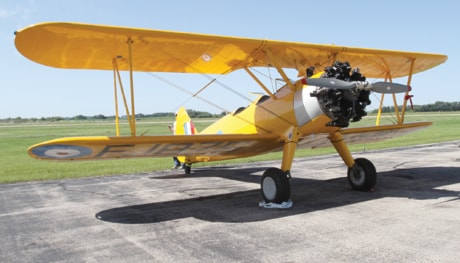When pilot Ulrich Bollinger flies over Central Alberta in his canary yellow Harvard Mark IV aircraft, he can see the remnants of history.
In farmers’ fields across Canada, a faint outline shows the original triangular airfields used in the British Commonwealth Air Training Plan, the massive joint aviation training program during the Second World War.
The airstrips, which included the hangars and buildings, were built in the shape of a triangle because it was easy to mass produce and replicate in a short time frame.
In Canada alone, roughly 250,000 air crew, including 55,000 who were pilots, were trained in 200 or more airports throughout the country for the Allied forces war efforts.
Bollinger, a volunteer pilot with Vintage Wings of Canada, is part of the Yellow Wings Tour bringing history to the skies and to communities across Canada.
As part of the tour, the Red Deer Regional Airport is hosting three restored vintage aircraft, which were used to train the air crews in the Second World War – the North American Harvard Mark IV, the Stearman PT27 Kaydet and the Fairchild Cornell MKII,
Painted a bright yellow to prevent mid-air collisions, each aircraft is dedicated to a surviving or deceased veteran of the Second World War.
Just a few days ago Bollinger flew over Bowden Institution, where the Stearman PT27 Kaydet aircraft was originally based as part of the war effort. The other two aircraft were based in Saskatchewan.
“You can see the soil texture,” said Bollinger. “It looks different. The colourings look different. You can still pick out the triangles. Of course many, many triangles are still in use today.”
The western provinces were used particularly for advanced training because of the favourable weather conditions. The Red Deer Regional Airport, formerly the Penhold Airport, was used as an advanced training base. Planes like the Harvard, Stearman and Cornell all flew out of the airport. Relief or satellite airfields were also constructed in Innisfail and in Bowden to handle the numerous crews and planes. Almost every major airport in Canada started out as a British Commonwealth training airport.
“It was a huge undertaking,” said Bollinger. “It exceeded the building of the TransCanada Railway. The biggest undertaking Canada ever did. It was hugely instrumental in determining the outcome of World War II.”
Canadian communities joined together to build the training infrastructure that helped train pilots and crews from Canada, the United States and Europe. Todd Lemieux, another Vintage Wings pilot, said many Canadians do not understand the extent and massive undertaking that occurred.
“They worked in shifts around the clock to make it happen,” he said. “You’d never do it today unless there was an act of war.”
Many of the facilities are still operational today in slightly different forms, like the Red Deer Regional Airport.
The tour flies out of Red Deer on Friday.
crhyno@www.reddeeradvocate.com
